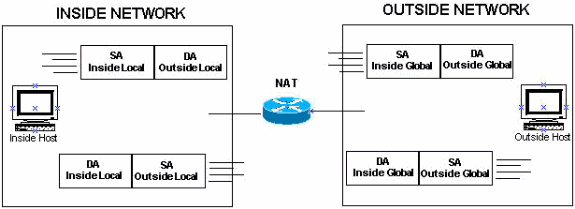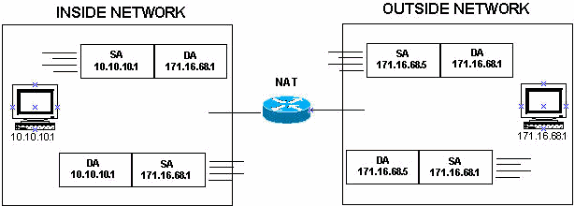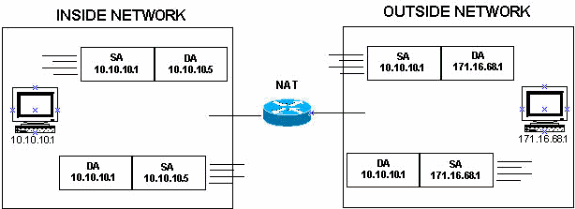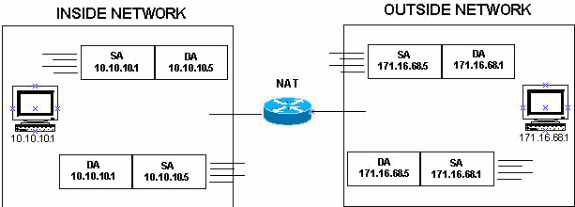Term Definitions:
Cisco defines these terms as follows:- Inside local address - The IP address assigned to a host on the inside network. This is the address configured as a parameter of the computer’s OS or received via dynamic address allocation protocols such as DHCP. The address is likely not a legitimate IP address assigned by the Network Information Center (NIC) or service provider.
- Inside global address - A legitimate IP address assigned by the NIC or service provider that represents one or more inside local IP addresses to the outside world.
- Outside local address - The IP address of an outside host as it appears to the inside network. Not necessarily a legitimate address, it is allocated from an address space routable on the inside.
- Outside global address - The IP address assigned to a host on the outside network by the host’s owner. The address is allocated from a globally routable address or network space.
- Local address - A local address is any address that appears on the “inside” portion of the network.
- Global address - A global address is any address that appears on the “outside” portion of the network.
Conversely, when a packet is sourced on the “outside” portion of the network, while it is on the “outside” network, its source address is known as the “outside global address.” The destination of the packet is known as the “inside global address.” When the same packet gets switched to the “inside” network, the source address is known as the “outside local address” and the destination of the packet is known as the “inside local address.”
This image provides an example.

Examples
These sections examine these terms more closely using the following topology and examples.

Define Inside Local and Inside Global Addresses
In the configuration below, when the NAT router receives a packet on its inside interface with a source address of 10.10.10.1, the source address is translated to 171.16.68.5. This also means that when the NAT router receives a packet on its outside interface with a destination address of 171.16.68.5, the destination address is translated to 10.10.10.1.
ip nat inside source static 10.10.10.1 171.16.68.5
!— Inside device A is known by the outside cloud as 171.16.68.5.interface s 0
ip nat inside
interface s 1
ip nat outside
When the inside device is communicating with the outside device, the addresses are defined in this way:
| Inside Global | Inside Local | Outside Local | Outside Global |
|---|---|---|---|
| 171.16.68.5 | 10.10.10.1 | 171.16.68.1 | 171.16.68.1 |
The following is what the packets look like when they are on the inside network and on the outside network.

Define Outside Local and Outside Global Addresses
In the next configuration, when the NAT router receives a packet on its outside interface with a source address of 171.16.68.1, the source address is translated to 10.10.10.5. This also means that if the NAT router receives a packet on its inside interface with a destination address of 10.10.10.5, the destination address is translated to 171.16.68.1.
ip nat outside source static 171.16.68.1 10.10.10.5
!— Outside device A is known to the inside cloud as 10.10.10.5.interface s 0
ip nat inside
interface s 1
ip nat outside
When the Outside Device A is communicating with Inside Device A the addresses are defined in the following way:
| Inside Global | Inside Local | Outside Local | Outside Global |
|---|---|---|---|
| 10.10.10.1 | 10.10.10.1 | 10.10.10.5 | 171.16.68.1 |
The following is what the packets look like when they are on the inside network and on the outside network.

Define All Local and Global Addresses
In the final configuration, when the NAT router receives a packet on its inside interface with a source address of 10.10.10.1, the source address is translated to 171.16.68.5. When the NAT router receives a packet on its outside interface with a source address of 171.16.68.1, the source address is translated to 10.10.10.5.
This also means that when the NAT router receives a packet on its outside interface with a destination address of 171.16.68.5, the destination address is translated to 10.10.10.1. Also, when the NAT router receives a packet on its inside interface with a destination address of 10.10.10.5, the destination address is translated to 171.16.68.1.
ip nat inside source static 10.10.10.1 171.16.68.5
!— Inside device A is known to the outside cloud as 171.16.68.5.
ip nat outside source static 171.16.68.1 10.10.10.5
!— device A is known to the inside cloud as 10.10.10.5.interface s 0
ip nat inside
interface s 1
ip nat outside
If Inside Device A were communicating with Outside Device A the addresses would be defined in the following way:
| Inside Global | Inside Local | Outside Local | Outside Global |
|---|---|---|---|
| 171.16.68.5 | 10.10.10.1 | 10.10.10.5 | 171.16.68.1 |
The following is what the packets look like when they are on the inside network and on the outside network.

In summary, the terms “local” and “global” are actually quite straight forward when we think of them in terms of where they appear in the network. Local addresses appear on the “inside” portion of the network while global addresses appear on the “outside” portion of the network. Also, depending on how NAT is configured, the local and global addresses for each (inside and outside) may be, or may not be, the same.
From : www.cisco.com








0 comments:
Post a Comment